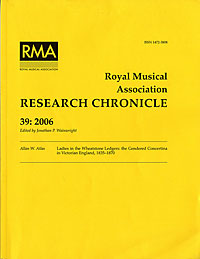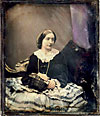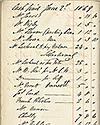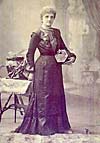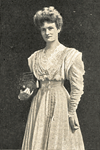Posted 30 January 2007
Ladies in the Wheatstone Ledgers:
the Gendered Concertina in Victorian England, 1835–18701
Allan W. Atlas
Prelude to the web edition
Victorian England had rather strict rules about musical instruments and gender, especially as
they concerned the question of which instruments were proper for amateur female musicians of
the middle and upper classes, women for whom music was a leisure-time activity, one among a
variety of “accomplishments.” Thus to play violin or cello, or any of the wind instruments,
was a decidedly unfeminine pursuit. In fact, the Royal Academy of Music did not admit its first
female violin student until 1872, and only in the final quarter of the century did the
strictures against women playing these instruments begin to loosen. (Men, we might note,
were discouraged from playing the piano, an instrument, that, if played by men, was better
suited for foreign virtuosos, whose masculinity was not quite that of their British counterparts.)
Which instruments were deemed proper for women? The conventional wisdom has long held that there
were three: piano, harp, and guitar. Yet what “Ladies in the Wheatstone Ledgers” shows is that
there was a fourth instrument deemed suitable for women: the English concertina.
The article that follows draws upon the nine extant Wheatstone & Co. sales ledgers that record
the firm’s sales, rentals, and exchanges from 1835 to 1870. It shows that of the 15,056 transactions
there listed, as many as 1,796—just under 12%—involved women (978 of them to be precise), among
whom were many from Victorian England’s socio-economic elite. This was no accident, for as I argue
towards the end of the essay, Wheatstone’s and other manufacturers of the English concertina often
advertised the instrument in terms specifically intended to catch the attention of women, a strategy
further reinforced in many of the period’s method books.
In all, the English concertina played an important role in domestic, amateur music-making: it was
the one instrument that cut across boundaries of gender, the one instrument on which husband and
wife, father and daughter, brother and sister could meet on common musical grounds.
Corrections:
After the original publication in the Royal Musical Association Research Chronicle
in October 2006 some corrections have been noticed (the page references are correct for both
the printed version and the online version):
p. 45, Table 13, entry 3: Ellen Attwater was Richard Blagrove’s niece (not his daughter).
p. 115, No. 348.01: Miss E. Geary is not just related to, but may be identical with the
Elizabeth Margaret Geary who wrote Musical Education with Practical Obserations on the Art
of Pianoforte Playing (1841); another Miss E. Geary can be identified as Miss Elizabeth Geary, a singer.
p. 182: Sophia Wheatstone was not Sir Charles’s daughter; rather, she was his older sister and gave
Regondi his first lessons on the concertina.
Needless to say, I would be happy to learn about other errors, as I would to hear about more likely
identifications of the many women about whom I do no more than speculate. We will keep the “corrections”
up-to-date. Just click on
to send me a correction or comment.
Allan W. Atlas
January 2007
-
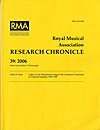 Ladies in the Wheatstone Ledgers:
Ladies in the Wheatstone Ledgers:
the Gendered Concertina in Victorian England, 1835-1870
-
by Allan W. Atlas
-
The entire article is a single PDF file which includes all 8 sections, iv+235 pages in total.
Size is about 5.6 megabytes. The text in the PDF file is searchable using the search tool in Acrobat Reader.
Click on the title or picture to open the document in PDF, or
right-click and choose “Save Target As …”
to save a personal copy of the entire file to your computer.
239 pages.
-
Posted 30 January 2007
-
» read full document (pp. i–235) in pdf (or right-click to download)
-
Individual Sections
The eight sections below, in individual PDF documents, collectively contain all the pages in the entire article. The text in each PDF file is searchable using
the search tool in Acrobat Reader.
Section 1: Publication Prelims, pages i–iv (size 49 kb)
-
» read prelims (pp. i–iv) in pdf (or right-click to download)
-
Section 2: Introduction, pages 1–57 (size 3,546 kb)
-
» read introduction (pp. 1–57) in pdf (or right-click to download)
-
Section 3: The Ledgers, pages 58–71 (size 1,398 kb)
-
» read the ledgers (pp. 58–71) in pdf (or right-click to download)
-
Section 4: The Inventory, pages 72–187 (size 446 kb)
-
» read the inventory (pp. 72–187) in pdf (or right-click to download)
-
Section 5: Appendix I: Chronological Index, pages 188–204 (size 76 kb)
-
» read appendix i (pp. 188–204) in pdf (or right-click to download)
-
Section 6: Appendix II: Serial Number Index, pages 205–222 (size 90 kb)
-
» read appendix ii (pp. 205–222) in pdf (or right-click to download)
-
Section 7: Appendix III: Price Index, pages 223–234 (size 68 kb)
-
» read appendix iii (pp. 223–234) in pdf (or right-click to download)
-
Section 8: Abstract, page 235 (size 31 kb)
-
» read abstract (p. 235) in pdf (or right-click to download)
From the Introduction:
The heart of this study is the inventory of women whose names appear in the nineteenth-century sales
ledgers of Wheatstone & Co., the period’s most prestigious manufacturer of the English
concertina.2
More specifically, the inventory is based on the nine extant sales ledgers, now housed at the
Horniman Museum, London, that list Wheatstone’s day-to-day sales from 4 April 1835 to 23 May
1870.3
In all, the ledgers record a total of 15,056
transactions,4
of which no fewer than 1,769 (just
under 12%) refer to and account for 978 women who either purchased, rented, exchanged, or borrowed
concertinas for their own use or, as with those who taught the instrument (see Tables 8 and
11), had such transactions carried out in their name with the intention of passing the instrument on to
someone else. Clearly, these figures come with an important caveat with respect to things that we cannot
know: (1) how many transactions entered under a woman’s name involved instruments ultimately
destined for men; (2) how many transactions signaled movement in the opposite direction; and
(3) how many concertinas sold to dealers ended up in the hands of women? In the end, we can only
tally up the transactions, take them at face value, and take note of those that specifically involve
women.
The Introduction, which analyses and provides the context for the data in the Inventory, is
divided into six sections: I. ‘Matters of Propriety’, II. ‘The English Concertina’, III. ‘The Clientele:
An Overview’, IV. ‘Ladies in the Ledgers’, V. ‘Marketing Strategies’, and VI. ‘Concluding Comment’.
It is followed by two brief sections: ‘The Ledgers’, which describes the nine sales ledgers and offers a
short note on one ‘production’ book (without the names of customers) and two salary books, and the
‘Preface to the Inventory’, which explains how the Inventory is organised and lists the sources (and
their sigla) cited therein. […]
Continue reading the entire article:
-
 Ladies in the Wheatstone Ledgers:
Ladies in the Wheatstone Ledgers:
the Gendered Concertina in Victorian England, 1835-1870
-
by Allan W. Atlas
-
The entire article is a single PDF file which includes all 8 sections, iv+235 pages in total.
Size is about 5.6 megabytes.
Click on the title or picture to open the document in PDF, or
right-click and choose “Save Target As …”
to save a personal copy of the entire file to your computer.
239 pages.
-
Posted 30 January 2007
-
» read full document (pp. i–235) in pdf (or right-click to download)
-
Have feedback on this article?
Send it to the author.
The original version of this article appeared in
Royal Musical Association Research Chronicle, Vol. 39 (2006),
pages i–235, published by the Royal Musical Association.
Reprinted from the Concertina Library
http://www.concertina.com
© Copyright 2000– by The Royal Musical Association and Allan W. Atlas

